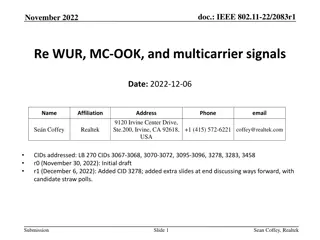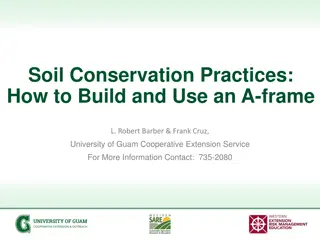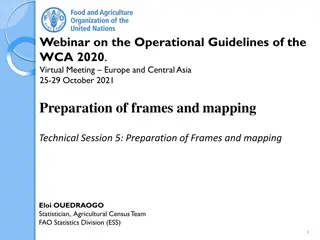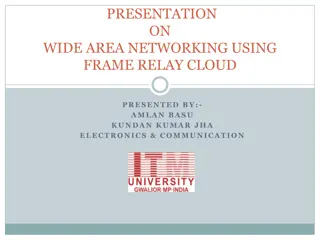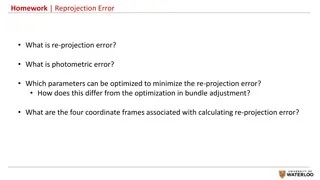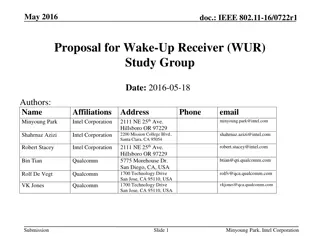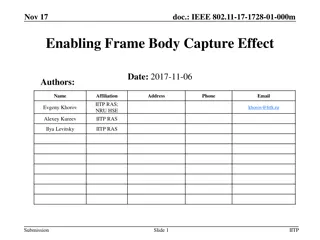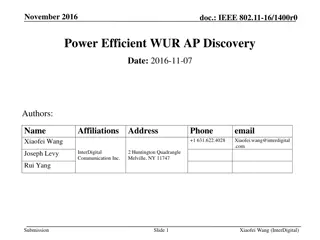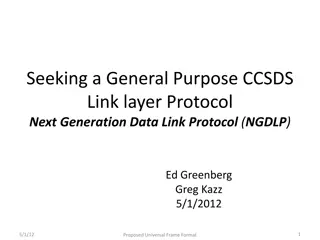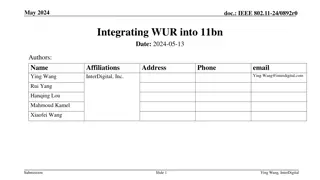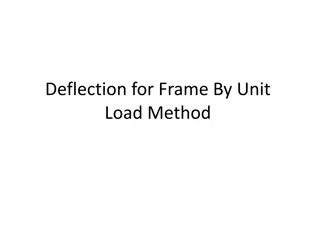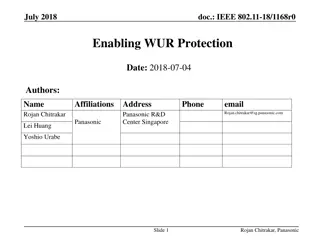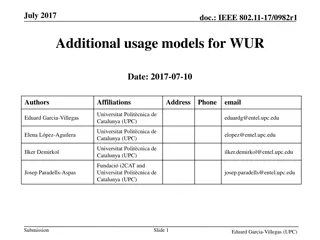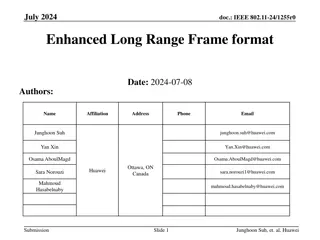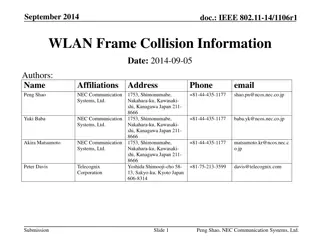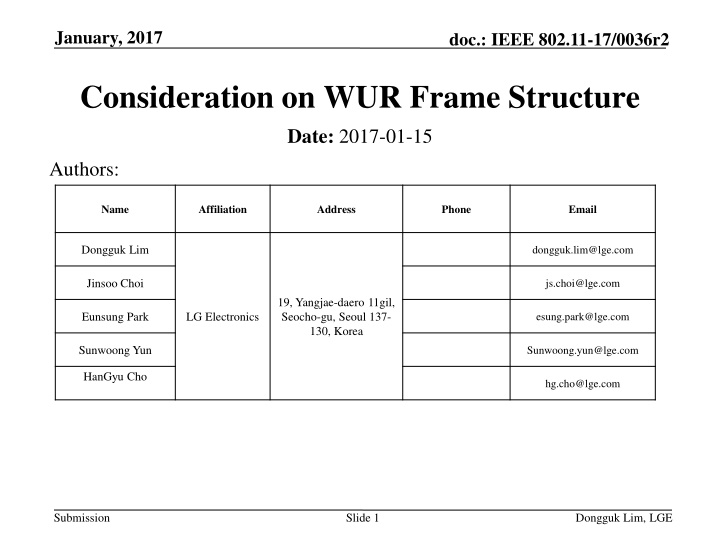
IEEE 802.11-17/0036r2 WUR Frame Structure Considerations
This document discusses the considerations for designing a new frame structure for the Wake-Up Radio (WUR) signal in IEEE 802.11-17/0036r2. It covers topics such as coexistence with legacy devices, transmission schemes, control information, and the use of narrow bands. The design aspects of the preamble, control information, and transmission methods are explored to enable effective WUR signal transmission.
Uploaded on | 8 Views
Download Presentation

Please find below an Image/Link to download the presentation.
The content on the website is provided AS IS for your information and personal use only. It may not be sold, licensed, or shared on other websites without obtaining consent from the author. If you encounter any issues during the download, it is possible that the publisher has removed the file from their server.
You are allowed to download the files provided on this website for personal or commercial use, subject to the condition that they are used lawfully. All files are the property of their respective owners.
The content on the website is provided AS IS for your information and personal use only. It may not be sold, licensed, or shared on other websites without obtaining consent from the author.
E N D
Presentation Transcript
January, 2017 doc.: IEEE 802.11-17/0036r2 Consideration on WUR Frame Structure Date: 2017-01-15 Authors: Name Affiliation Address Phone Email Dongguk Lim dongguk.lim@lge.com Jinsoo Choi js.choi@lge.com 19, Yangjae-daero 11gil, Seocho-gu, Seoul 137- 130, Korea Eunsung Park LG Electronics esung.park@lge.com Sunwoong Yun Sunwoong.yun@lge.com HanGyu Cho hg.cho@lge.com Submission Slide 1 Dongguk Lim, LGE
January, 2017 doc.: IEEE 802.11-17/0036r2 Introduction WUR (11ba) should support the following scope in PAR [1] The WUR devices coexist with legacy IEEE 802.11 devices in the same band The WUR meets the same range requirement as the primary connectivity radio The wake-up frames carry only control information As introduced in [2], WUR signal may be transmitted by using the different transmission scheme from conventional system, such as OOK modulation and narrow bandwidth To satisfy the decided target and to apply the different transmission method, we need a new WUR frame structure for the WUR signal In this contribution, we discuss how to design the WUR frame structure Submission Slide 2 Dongguk Lim, LGE
January, 2017 doc.: IEEE 802.11-17/0036r2 Overview For the new WUR frame structure, we discuss the following points in this contribution First, We discuss how to design the preamble by considering the characteristic of OOK signals and the following functions such as Coexistence with legacy devices, Time synch. and packet detection Second, To wake-up the primary radio, we discuss what control information is needed and how to configure it Third, WUR can be transmitted by using a narrow band or a part of available tones in 20MHz. So, we also discuss how to use the narrow band to transmit the WUR signals Submission Slide 3 Dongguk Lim, LGE
January, 2017 doc.: IEEE 802.11-17/0036r2 Frame Structure : Preamble (1/4) - Coexistence Considered requirement: The WUR devices coexist with legacy IEEE 802.11 devices in the same band If the WUR signal consists of OOK signal, it requires a part for legacy device to decode the packet for deferring channel access As the WUR signal starts with L-part, legacy devices can detect the WUR packet and decide how long they need to defer channel access L-length field in L-SIG can be used by legacy devices for the information We support to use the L-part in the WUR signal at the beginning of the WUR preamble WUR symbols L-STF L-LTF L-SIG WUR-preamble part L-Part, OFDM symbol WUR Part, OOK symbol Submission Slide 4 Dongguk Lim, LGE
January, 2017 doc.: IEEE 802.11-17/0036r2 Frame Structure : Preamble (2/4) Time Synch L-part is only for legacy devices rather than WUR devices (assuming the WUR receiver may not decode an OFDM signal) So, the timing synch. and packet detection should be done in the other part (e.g. WUR preamble) when the WUR devices receive a WUR signal It can be considered to add a WUR preamble right after the L-part Candidate design on the WUR preamble with OOK signal Timing synchronization: we can consider using a training field (symbols) after L- part An OOK ON symbol ( 1 ) is used for the purpose of training symbol This training field can be repeated over more than 1 symbols To minimize latency and preamble overhead, it is desirable to use a few number of training symbols as possible Training field with a few symbols shows no performance degradation compared to using larger number of training symbols as shown in appendix A But, we should take into account the power consumption in receiver, because we assumed dozen s of samples within a symbol to be used for sync. So it s expected more symbols will be required if we want the similar performance with lower power consumption. Submission Slide 5 Dongguk Lim, LGE
January, 2017 doc.: IEEE 802.11-17/0036r2 Frame Structure : Preamble (3/4) Time Synch An OOK OFF ( 0 ) symbol can be inserted after the last training symbol Only one OOK OFF symbol may be enough By using the OOK OFF symbol at WUR preamble part, the WUR receiver can recognize the end of preamble And, it is able to help measuring the timing synch. It can prevent data part from being used when performing the timing synch. with preamble because same OOK symbol can be used for data Preamble part L-part Repetition of same symbol Training Symbol1 Training Symbol2 OFF symbol L-STF L-LTF L-SIG 4us Submission Slide 6 Dongguk Lim, LGE
January, 2017 doc.: IEEE 802.11-17/0036r2 Frame Structure : Preamble (4/4) Packet Detection Packet detection: the WUR preamble can be used for the purpose of WUR packet recognition The WUR preamble consists of repeated value of training symbols that enables for the WUR receiver to recognize a WUR packet Through decoding OOK ON symbols of preamble, WUR receiver can figure out continuously identical bit information For more reliable packet detection, it may be required to use more training symbols (FFS) By decoding the last symbol of preamble, the WUR receiver detects the one termination bit information (e.g. 0) after consecutive bits with same value This can help recognizing the WUR packet as a known pattern Submission Slide 7 Dongguk Lim, LGE
January, 2017 doc.: IEEE 802.11-17/0036r2 Frame Structure : Control information (1/2) Considered requirement: wake-up frames carry only control information A WUR frame can be constructed by following two parts The preamble part (as discussed in previous slides) The control information part For the control information part, since the primary goal of WUR is to wake up the primary radio, it is desirable to carry the simple and compact control information considering an OOK symbol has a difficulty in conveying multiple bits BSS identification To distinguish whether the received WUR frame is from its own BSS or not Full BSSID will be most accurate, but the required overhead may be too high BSS color, partial BSSID can be considered STA identification To identify the intended recipient(s) For single STA : AID or P-AID For multiple STA : a series of AID or Group ID A type indication like SU/MU may be needed depending on the control information type Submission Slide 8 Dongguk Lim, LGE
January, 2017 doc.: IEEE 802.11-17/0036r2 Frame Structure : Control information (2/2) Other beneficial information (FFS) Channel/bandwidth (e.g. indicating which or how many channels are used for the main data transmission) DL/UL indication of WUR PPDU (e.g. Different identification type/size or control information may be required depending on DL/UL) Also, we may consider conveying BSS identification information (e.g. BSS color) right after preamble part for early indication We can put a PHY header (no interaction proceeded with MAC if other BSS) After checking, if it is from its own BSS, the receiver continue decoding the other information in control information part And, we may consider BSS identification can be included in preamble part like as in [3] Submission Slide 9 Dongguk Lim, LGE
January, 2017 doc.: IEEE 802.11-17/0036r2 Frame Structure : Channelization (narrow band) The WUR frame should be started with 20MHz channel because of L-part in front of the frame But, as introduced in [2], WUR signal except the L-part can be transmitted by using narrow band than 20MHz The narrow band can consist of a part of available tones within 20MHz [3] For example, 4MHz (i.e. 13 subcarriers), 8MHz (i.e. 26 subcarrier), 10MHz (i.e. 32 subcarriers) According to used band size, multiple allocations in 20MHz might be considered for WUR signal transmission For example, if 8MHz band is used for a WUR signal, we can use maximum two bands in 20MHz But, by using the two bands simultaneously, we may not get enough power gain from narrow band transmission (under the regulation limit) And, more power might be needed at WUR receiver because it requires more accurate filtering Therefore, using one narrow band in 20 MHz for WUR transmission may be desirable (but, open to using multiple narrow bands) Submission Slide 10 Dongguk Lim, LGE
January, 2017 doc.: IEEE 802.11-17/0036r2 Candidate WUR Frame Structure Based on the previous slides, our considered WUR frame structure is shown as following WUR PPDU Preamble part L-part Control information part Repetition of same symbol Training Symbol1 Training Symbol2 L-STF L-LTF 20MHz OFF symbol L-SIG 4us 4us OOK signal If the WUR frame is transmitted for a certain case without control information, e.g. broadcasting to all WUR STAs, the WUR frame may be simply constructed by L-part and Preamble part Submission Slide 11 Dongguk Lim, LGE
January, 2017 doc.: IEEE 802.11-17/0036r2 Conclusion In order to satisfy the target scope of PAR, we considered the WUR frame structure from various perspectives such as Coexistence, timing synchronization and packet detection, control information and channelization Considering all of factors as described above, we can design a new WUR frame structure as shown in slide 11 For the coexistence with legacy devices, the L-part should be transmitted at the first in a WUR PPDU with 20MHz The preamble part can be constructed with consecutive ON symbols and one OFF symbol for the time synch. and packet detection Also, by considering symbol overhead with OOK modulation, compact control information is recommended Submission Slide 12 Dongguk Lim, LGE
January, 2017 doc.: IEEE 802.11-17/0036r2 Straw Poll 1 Do you agree that a WUR PPDU includes the L-part (L- STF, L-LTF, L-SIG)? Submission Slide 13 Dongguk Lim, LGE
January, 2017 doc.: IEEE 802.11-17/0036r2 Straw Poll 2 Do you agree that a WUR PPDU includes the WUR preamble, which is different from that in the L-part? Submission Slide 14 Dongguk Lim, LGE
January, 2017 doc.: IEEE 802.11-17/0036r2 Reference [1] 11-16-1045r09-a par proposal for wake-up radio [2] 11-16-034r0 LP-WUR(Low-Power Wake-Up Receiver Follow Up) [3] 11-17-0030r0 - On the Performance of Timing Synchronization and OOK Pulse Bandwidth [4] 11-17-0031r0 - Channel issue in WUR Submission Slide 15 Dongguk Lim, LGE
January, 2017 doc.: IEEE 802.11-17/0036r2 Appendix A Performance according to the number of symbols - 48 bit control information assumed TGnD UMi Submission Slide 16 Dongguk Lim, LGE


